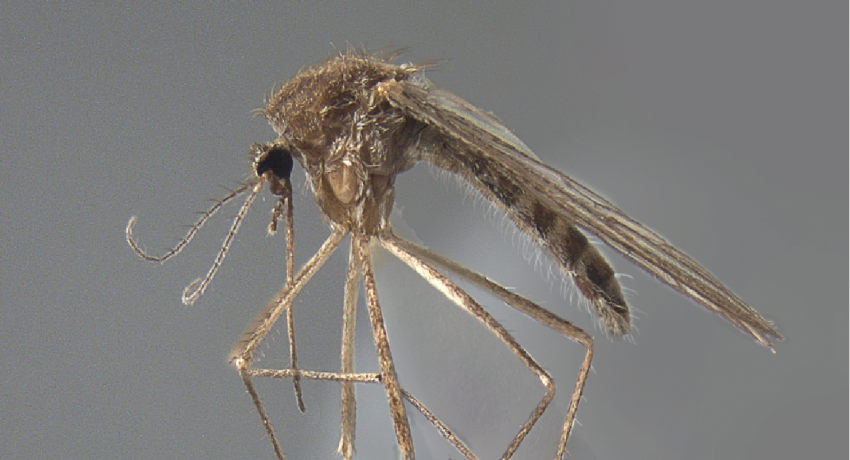NEARCTIC REGION
Informal name: Unadorned American Cool Mosquito
Etymology: not stated [unadorned (L); possibly refers to lack of banding and other diagnostic characters]
Culiseta inornata is a large drab mosquito found throughout mainland United States and into western Canada, south to Mexico and Cuba. It is placed in the subgenus Culiseta, and is an important arbovirus vector in the Nearctic.
Type locality: Argus Mountains, California, United States
Type depository: U.S. National Museum, Washington, D.C., United States (USNM)
DIAGNOSTIC CHARACTERS (Click photos to view; mouse over and click large photo to zoom in.)
ADULT: (illustrated): Thorax: Pale scales present on paratergite and postspiracular area. Wing: Speckled brown and white scales on three anterior veins. Legs: Fe-I–III, Ti-I–III, and Ta-I–III1,2 distinctly speckled with cream-colored scales; Ta-III5 entirely dark.
LARVA (not illustrated): Head: Antenna shorter than head length; seta 1-A inserted near midpoint of antenna. Thorax: Seta 4-C 3–5 branched; seta 6-C distinctly longer than 5,7-C. Abdominal segments: Seta 1-VI,VII as long as seta 1-V. Terminal segments: Siphon index about 4; seta 1-S with even row of long setae distal to pecten; saddle smooth, without large spicules at apex; seta 1-X 1-5 branched, as long or longer than saddle.
TAXONOMIC KEYS
Carpenter & LaCasse 1955
Dodge 1966
Maslov 1989
Bohart & Washino 1978
Darsie & Ward 2005
Harrison et al. 2016
Exemplar DNA sequences
Cs. inornata COI: HQ569463, JX259935–41, JX260672–74
BIONOMICS
Immatures
Immature Cs. inornata are typically found in small, often grossly polluted, ephemeral water bodies, including puddles, ground pools, and ditches, but they have also been reported occasionally in artificial containers, including neglected swimming pools. Larva have also been collected in coastal brackish water marshes in California, and are able to complete their development in dilutions of sea water ranging from 50–700 mosmol/kg. Larvae are hardy and have been recovered from ice-covered ground pools in northern parts of their range.
Adults
Female Cs. inornata feed almost exclusively on horses and ruminants, including deer and cows, but will occasionally feed on people, birds or pigs. They are fierce night-biters, and can be very troublesome to livestock in wooded areas when their numbers are high in early spring. Culiseta inornata produce multiple generations per year (multivoltine). In the southern United States, adults are active all throughout the winter, and parous or gravid females aestivate in cellars and barns during the warmer summer months. Males do not survive this period.
DISTRIBUTION NOTES
Canada, Cuba, Mexico, United States (continental).

WRBU VECTOR HAZARD REPORTS
VHR: Southern US and Northern Mexico
View other WRBU Vector Hazard Reports
Available GIS Models:
Cs_inornata_Dornak_1 North America
IMPORTANT REFERENCES (full citations below)
Williston 1893: 253 (F; Culex)
Howard et al. 1913 (1912), figures 691-692 (E*)
Darsie 1951: 39 (P*)
Rees & Onishi 1951: 233 (M*, F*)
Yamaguti & LaCasse 1951a: 67 (M*, F*, L*)
Carpenter & LaCasse 1955: 89 (M*, F*, L*; keys)
Dodge 1966: 372 (1st instar L*; key)
Maslov 1989: 195 (M*, F, L*; keys, distribution, bionomics)
Owen 1977 (morphology)
Bohart & Washino 1978: 32 (M*, F*, L*; keys, taxonomy, bionomics, distribution)
Owen 1980 (morphology)
Darsie & Ward 2005 (F*, L*; keys, distribution)
Harrison et al. 2016 (F*, L*; keys, distribution)
CURRENT SYNONYMS
syn. magnipennis Felt
1904: 322 (M*, F*, L*; Culex). Type locality: Sodus Point, New York, United States (NY). References: Leicester 1908: 99 (M; as annulitarsis).
CITED REFERENCES
Bohart, R.M. & Washino, R.K. (1978). Mosquitoes of California (3rd ed.). Berkeley, CA: University of California, Agriculture and Natural Resources.
Carpenter, S.J., & LaCasse, W.J. (1955). Mosquitoes of North America (North of Mexico). Berkeley, Los Angeles: University of California Press.
Darsie, R.F., Jr. (1951). Pupae of the culicine mosquitoes of the northeastern United States (Diptera, Culicidae, Culicini). Ithaca, NY: Cornell University Agricultural Experiment Station Memoir 304.
Darsie, R.F., Jr., & Ward, R.A. (2005). Identification and geographical distribution of the mosquitoes of North America, North of Mexico. Gainesville, FL: University Press of Florida.
Dodge, H. R. (1966). Studies on mosquito larvae II. The first-stage larvae of North American Culicidae and of world Anophelinae. Canadian Entomologist, 98, 337–393.
Felt, E.P. (1904). Mosquitos or Culicidae of New York State. Bulletin of the New York State Museum, 79, 241–400.
Harrison, B.A., Byrd, B.D., Sither, C.B., & Whitt, P.B. (2016). The mosquitoes of the Mid-Atlantic Region: an identification guide (Vol. 1). Madison Heights, MI: Publishing XPress.
Howard, L.O., Dyar, H.G., & Knab, F. (1913). The mosquitoes of North and Central America and the West Indies. (Vol. II) (1912). Washington, D.C.: Carnegie Institution of Washington.
Leicester, G.F. (1908). The Culicidae of Malaya. Studies from the Institute for Medical Research, Federated Malay States, 3(3), 18–261.
Maslov, A.V. (1989). Bloodsucking mosquitoes of the subtribe Culisetina (Diptera, Culicidae) of the world fauna. Ronald A. Ward, scientific editor. Translated from the Russian. Amerind Publ Pvt Ltd, New Delhi.
Owen, W.B. (1977). Morphology of the thoracic skeleton and muscles of the mosquito, Culiseta inornata (Williston), (Diptera: Culicidae). Journal of Morphology, 153, 427–460.
Owen, W.B. (1980). Morphology of the abdominal skeleton and muscles of the mosquito, Culiseta inornata (Williston) (Diptera: Culicidae). Journal of Morphology, 166(2), 155–178.
Rees, D.M., & Onishi, K. (1951). Morphology of the terminalia and internal reproductive organs, and copulation in the mosquito, Culiseta inornata (Williston) (Diptera, Culicidae). Proceedings of the Entomological Society of Washington, 53, 233–246.
Williston, C.V. (1893). List of Diptera of the Death Valley Expedition. In Riley, C. V. Report on a small collection of insects made during the Death Valley Expedition. North American Fauna No. 7, pp. 235–268.
Yamaguti, S., & La Casse, W.J. (1951a). Mosquito fauna of North America. Part II. Genera Megarhinus, Wyeomyia, Uranotaenia and Culiseta. Office of the Surgeon General, Headquarters, 8th Army, APO 343. United States. 207th Malaria Survey Detachment.
CITE THIS PAGE
Walter Reed Biosystematics Unit (Year). Culiseta inornata species page. Walter Reed Biosystematics Unit Website, http://wrbu.si.edu/vectorspecies/mosquitoes/inornata, accessed on [date (e.g. 03 February 2020) when you last viewed the site].









































































































































































